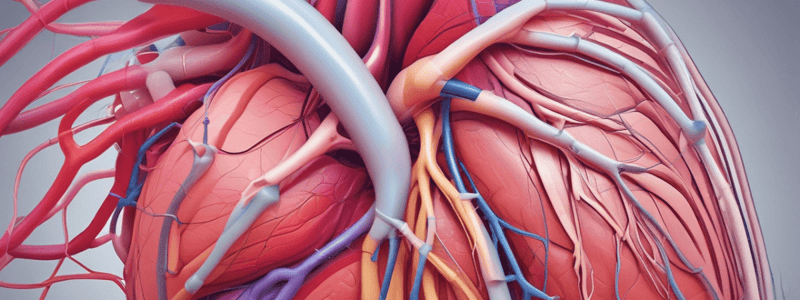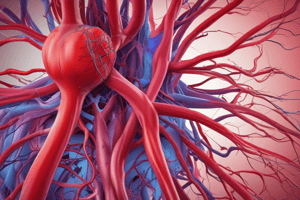Podcast
Questions and Answers
Which of the following best describes the relationship between pulse pressure and the elasticity of the aorta?
Which of the following best describes the relationship between pulse pressure and the elasticity of the aorta?
- Pulse pressure is unrelated to the elasticity of the aorta.
- Pulse pressure is related to the elasticity of the aorta, but the relationship is complex and varies with other factors.
- Pulse pressure is inversely related to the elasticity of the aorta.
- Pulse pressure is directly related to the elasticity of the aorta. (correct)
What is the formula used to approximate mean arterial pressure (MAP)?
What is the formula used to approximate mean arterial pressure (MAP)?
- MAP = 2/3 systolic pressure + 1/3 diastolic pressure (correct)
- MAP = 1/4 systolic pressure + 3/4 diastolic pressure
- MAP = 1/2 systolic pressure + 1/2 diastolic pressure
- MAP = 1/3 systolic pressure + 2/3 diastolic pressure
How does systolic blood pressure typically change with age?
How does systolic blood pressure typically change with age?
- Systolic blood pressure first increases and then decreases with age.
- Systolic blood pressure remains constant throughout life.
- Systolic blood pressure decreases with advancing age.
- Systolic blood pressure increases with advancing age. (correct)
How does diastolic blood pressure typically change with age?
How does diastolic blood pressure typically change with age?
What is the typical effect of anxiety on blood pressure?
What is the typical effect of anxiety on blood pressure?
How does exercise typically affect diastolic blood pressure?
How does exercise typically affect diastolic blood pressure?
What is the primary determinant of the diastolic blood pressure?
What is the primary determinant of the diastolic blood pressure?
During exercise, which of the following is the MAIN mechanism responsible for the increase in systolic blood pressure?
During exercise, which of the following is the MAIN mechanism responsible for the increase in systolic blood pressure?
What is the MAIN physiological function of the pulse pressure?
What is the MAIN physiological function of the pulse pressure?
Which of the following is the MOST important factor in determining the mean arterial pressure?
Which of the following is the MOST important factor in determining the mean arterial pressure?
During a Valsalva maneuver, which of the following is the MAIN reason for the temporary decrease in diastolic blood pressure?
During a Valsalva maneuver, which of the following is the MAIN reason for the temporary decrease in diastolic blood pressure?
Which of the following is the MOST important long-term regulator of blood pressure?
Which of the following is the MOST important long-term regulator of blood pressure?
Which of the following statements about the effect of gravity on blood pressure is correct?
Which of the following statements about the effect of gravity on blood pressure is correct?
What is the recommended patient position for measuring blood pressure?
What is the recommended patient position for measuring blood pressure?
Which of the following statements about the time of blood pressure measurement is correct?
Which of the following statements about the time of blood pressure measurement is correct?
According to the information provided, which of the following equations correctly represents the relationship between arterial pressure, cardiac output, and peripheral resistance?
According to the information provided, which of the following equations correctly represents the relationship between arterial pressure, cardiac output, and peripheral resistance?
What is the primary driving force for blood flow through the tissues of the body?
What is the primary driving force for blood flow through the tissues of the body?
Which of the following statements accurately describes the pressure gradient required for blood flow through a vascular bed?
Which of the following statements accurately describes the pressure gradient required for blood flow through a vascular bed?
Flashcards
Blood Pressure Measurement
Blood Pressure Measurement
Sitting, after 5 minutes, arm at mid-sternum, sphygmomanometer at eye level.
Why measure BP in supine/standing in elderly?
Why measure BP in supine/standing in elderly?
To check for a drop in blood pressure when standing.
Arterial Pressure Factors
Arterial Pressure Factors
Cardiac output (Q) and peripheral resistance (R).
Pressure Gradient Equation
Pressure Gradient Equation
Signup and view all the flashcards
Cardiac Output
Cardiac Output
Signup and view all the flashcards
Short-Term BP Regulation
Short-Term BP Regulation
Signup and view all the flashcards
Long-Term BP Regulation
Long-Term BP Regulation
Signup and view all the flashcards
Blood Pressure
Blood Pressure
Signup and view all the flashcards
Systolic BP
Systolic BP
Signup and view all the flashcards
Diastolic BP
Diastolic BP
Signup and view all the flashcards
Pulse Pressure
Pulse Pressure
Signup and view all the flashcards
Mean Arterial Pressure (MAP)
Mean Arterial Pressure (MAP)
Signup and view all the flashcards
Blood Pressure and Age
Blood Pressure and Age
Signup and view all the flashcards
BP in Women vs. Men (Age)
BP in Women vs. Men (Age)
Signup and view all the flashcards
Anxiety and Blood Pressure
Anxiety and Blood Pressure
Signup and view all the flashcards
Blood Pressure During Sleep
Blood Pressure During Sleep
Signup and view all the flashcards
Exercise and Blood Pressure
Exercise and Blood Pressure
Signup and view all the flashcards
Obesity and Hypertension
Obesity and Hypertension
Signup and view all the flashcards
Study Notes
Blood Pressure Measurement
- Blood pressure should be measured in a sitting position, after sitting for 5 minutes, with the arm levelled with the mid-sternum and sphygmomanometer at eye level.
- In elderly patients, supine and standing positions can be used to detect postural hypotension.
- Blood pressure should be measured at different times during the waking hours of the patient, especially for patients taking antihypertensive medications.
Factors Affecting Arterial Blood Pressure
- Arterial pressure (∆P) is determined by cardiac output (Q) and peripheral resistance (R): ∆P = Q x R
- The pressure gradient between the aorta and the right atrium equals the rate of blood flow (F) times the resistance to flow (R): ∆P = F x R
- Cardiac output is the total blood flow through the systemic circulation.
Blood Pressure Regulation
- Short-term regulatory mechanisms of ABP include nervous reflexes.
- Long-term regulatory mechanisms of ABP involve the adjustment of body fluids and blood volume, and the role of capillary fluid shift and hormones.
Blood Pressure Definitions
- Blood pressure is the force exerted by the blood against any unit area on a vessel wall, measured in mmHg.
- Systolic BP is the maximum pressure exerted in the arteries during systole, ranging from 100-140 mmHg.
- Diastolic BP is the minimum pressure within the arteries during diastole, ranging from 60-90 mmHg.
- Pulse pressure is the difference between systolic and diastolic pressures, normally about 40 mmHg.
- Mean arterial pressure (MAP) is the average pressure throughout the cardiac cycle, normally about 93 mmHg.
Physiological Variations of Blood Pressure
- Blood pressure increases with advancing age.
- BP is lower in young women than young men until age 55-65, after which they become comparable.
- Anxiety raises BP, especially systolic BP, due to increased sympathetic stimulation.
- BP normally falls during sleep, and increases slightly after meals due to vasodilation in the splanchnic area.
- Systolic BP increases markedly during exercise, while diastolic BP does not change or even decreases with endurance exercise.
- There is an association between obesity and hypertension.
Studying That Suits You
Use AI to generate personalized quizzes and flashcards to suit your learning preferences.




